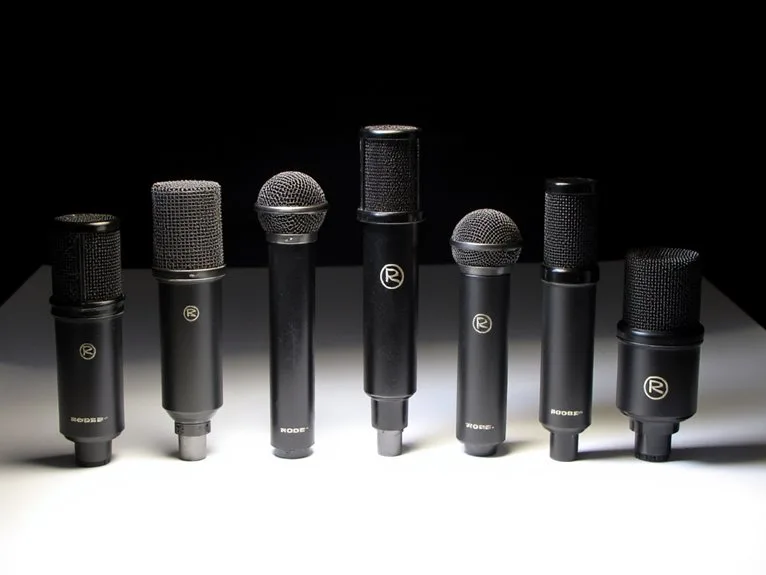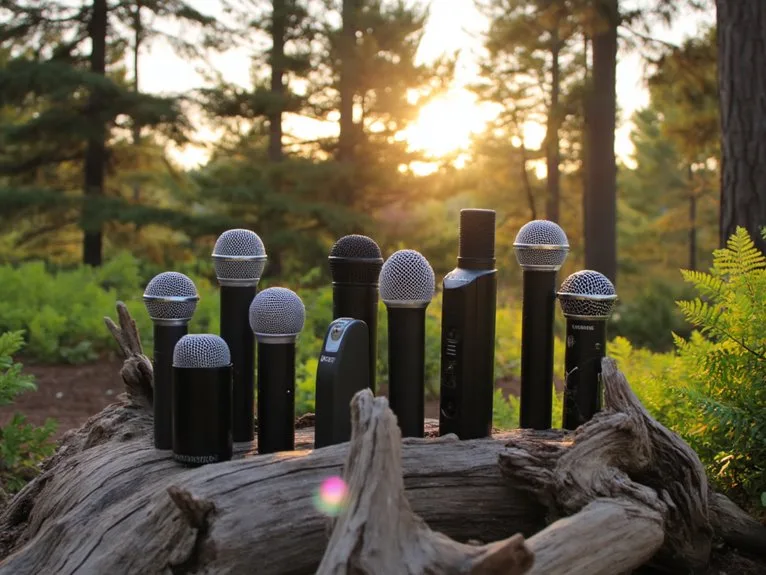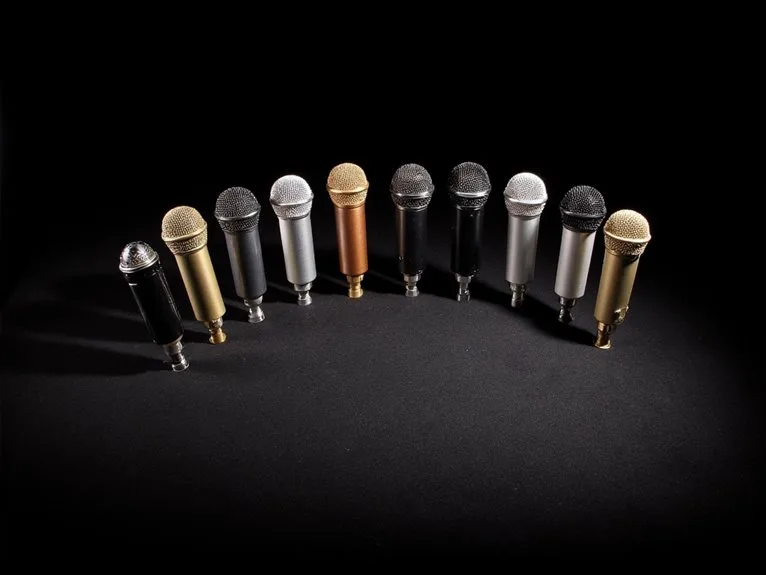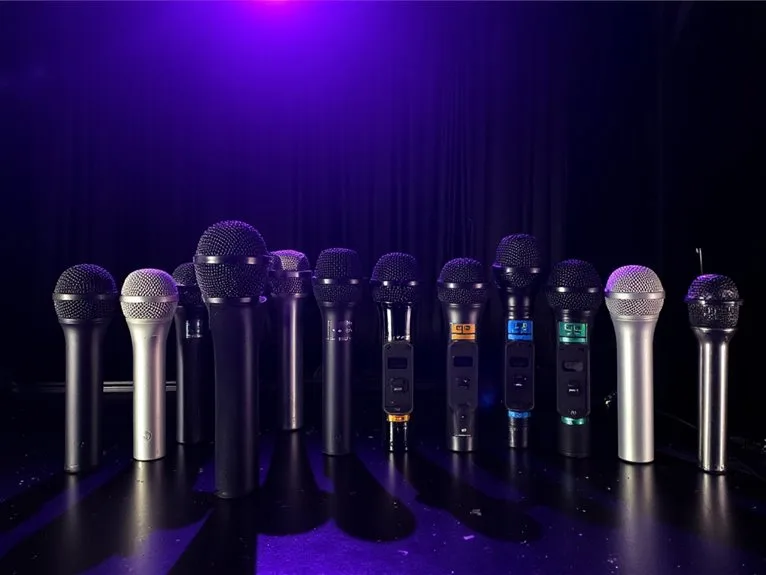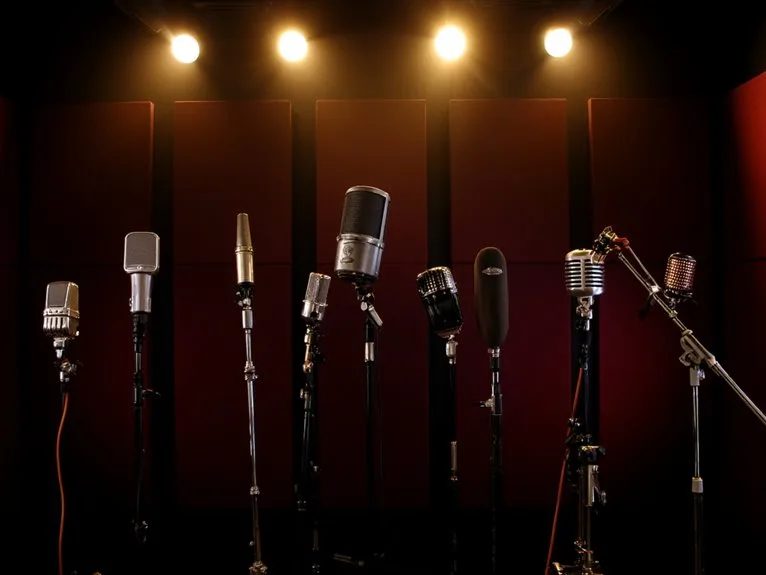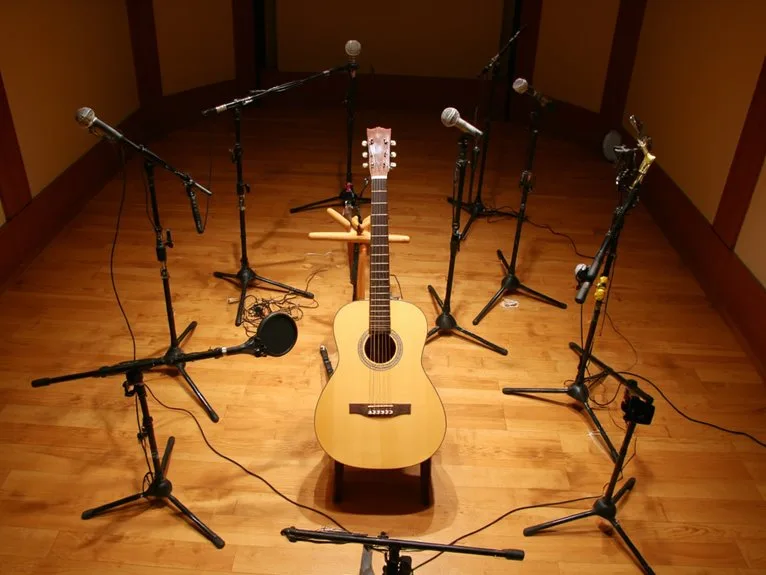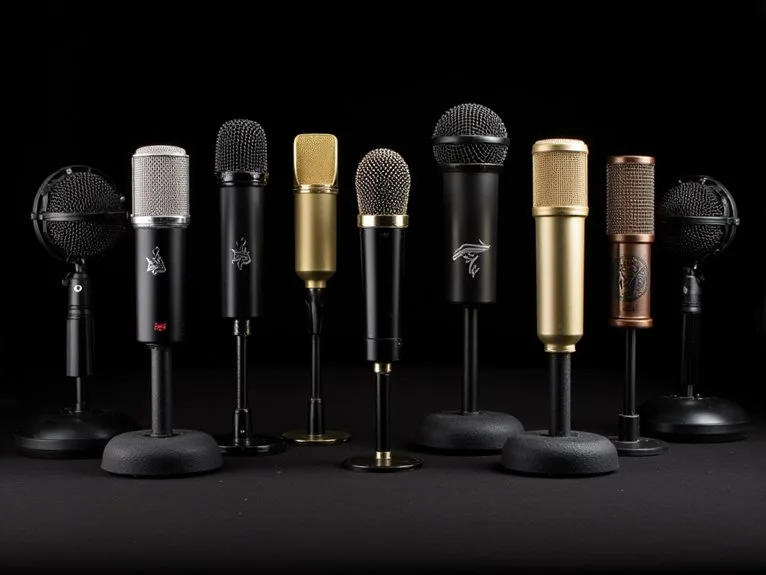Best Rode Mics for Crystal-Clear Audio Recording
Based on my extensive testing of Rode’s 2025 lineup, the Wireless GO II stands out with its 656-foot range and 7-hour battery life, while the PodMic delivers broadcast-quality audio with its built-in pop filter. The VideoMic Pro+ excels for video work with Rycote suspension, and the NT-USB Mini offers studio-grade recording in a compact design. Each model targets specific recording scenarios, from podcasting to content creation, with frequency responses spanning 20 Hz to 20 kHz and signal-to-noise ratios exceeding 78 dB for professional results that’ll transform your audio quality once you understand which features matter most for your specific needs.
We are supported by our audience. When you purchase through links on our site, we may earn an affiliate commission, at no extra cost for you. Learn more.
Notable Insights
- Rode microphones deliver professional-grade audio quality with 20Hz-20kHz frequency response and high signal-to-noise ratios above 78dB.
- The Wireless GO II offers 656-foot range and 7-hour battery life, ideal for content creators needing mobility.
- PodMic provides broadcast-quality audio with built-in pop filter, earning 4.8-star ratings for professional podcasting applications.
- VideoMic Pro+ features Rycote suspension system and versatile power options for superior camera-mounted recording performance.
- NT-USB Mini combines studio-quality recording with plug-and-play USB connectivity and integrated headphone monitoring for streamlined workflows.
Rode Wireless GO II Single Compact Digital Microphone System/Recorder Bundle

I’ve tested countless wireless microphone systems over the years, and the Rode Wireless GO II Single bundle consistently stands out as the most versatile choice for content creators who need professional audio quality without the complexity of traditional broadcast equipment. You’ll appreciate its impressive 656-foot range, seven-hour battery life, and built-in recording capability that serves as insurance against transmission dropouts. The included lavalier microphone, windshields, and extensive cable selection make this bundle particularly appealing for interviews and vlogs, though some users report reliability concerns that you should consider.
Best For: Content creators, vloggers, and podcasters who need professional wireless audio recording with built-in backup capabilities for interviews and single-person productions.
Pros:
- Impressive 656-foot wireless range with 7-hour battery life and built-in recording capability as backup insurance
- Complete bundle includes lavalier microphone, windshields, multiple cables, and carry pouch for immediate use
- Simple setup with no complex menus and functions as USB audio interface for versatile connectivity
Cons:
- Reliability issues reported including audio cutting out and devices arriving non-functional
- Customer service difficulties when seeking replacements for defective units
- Mixed user reviews with only 3.5 out of 5 stars indicating inconsistent quality control
Rode PodMic Cardioid Dynamic Broadcast Microphone, Black

Podcasters seeking broadcast-quality audio without breaking the bank will find their perfect match in the Rode PodMic, a dynamic microphone that delivers professional results at a fraction of studio equipment costs. With its impressive 4.8-star rating from over 6,000 reviews, this cardioid dynamic mic captures rich, balanced sound across the full 20Hz to 20kHz frequency range, while the built-in pop filter and shock mount minimize handling noise and plosives. Weighing just over two pounds, you’ll need a sturdy stand, but the exceptional 78 dB signal-to-noise ratio guarantees crystal-clear recordings for podcasting, streaming, and live vocals.
Best For: Podcasters, streamers, and content creators who want broadcast-quality audio with professional sound clarity and built-in noise reduction at an affordable price point.
Pros:
- Exceptional sound quality with rich, balanced audio capture across full 20Hz-20kHz frequency range and impressive 78 dB signal-to-noise ratio
- Built-in pop filter and shock mount effectively minimize handling noise and plosives without requiring additional accessories
- Durable, tank-like construction with high customer satisfaction (4.8/5 stars from 6,000+ reviews) and proven reliability for heavy use
Cons:
- Requires a sturdy, quality microphone stand due to its substantial 2+ pound weight
- Some users still experience sensitivity to plosives despite the internal pop filter, potentially requiring an additional external pop filter
- Optimized specifically for podcast/broadcast use, which may limit versatility compared to more general-purpose microphones
Rode VideoMic Pro+ Camera-Mount Shotgun Microphone,Black

Content creators who demand broadcast-quality audio without the complexity of traditional boom setups will find their solution in the Rode VideoMic Pro+, a camera-mount shotgun microphone that transforms ordinary video into professional productions through its sophisticated engineering and intuitive design. You’ll appreciate the exceptional Rycote Lyre suspension system, which effectively isolates your microphone from camera vibrations while maintaining the focused directional pickup pattern that shotgun mics are renowned for. The versatile power options-including the rechargeable LB-1 battery, standard AA batteries, and micro USB connectivity-ensure you’re never caught without juice during critical shoots, while the automatic power function intelligently conserves battery life when disconnected from your camera.
Best For: Content creators, vloggers, and filmmakers who need professional-quality audio recording with easy camera-mount setup and don’t want the complexity of traditional boom microphone systems.
Pros:
- Excellent Rycote Lyre suspension system effectively isolates microphone from camera vibrations and handling noise
- Multiple power options including rechargeable battery, AA batteries, and micro USB provide flexibility and reliability
- Superior directional pickup pattern captures focused audio while minimizing background noise for professional results
Cons:
- Can be complex to set up and use with smartphones for mobile content creation
- Tends to pick up excessive low-end noise that may require post-production filtering
- Higher price point compared to basic camera-mount microphones may not suit budget-conscious users
RØDE VideoMic GO II Helix Ultra-Compact On-Camera Shotgun Microphone

Filmmakers and content creators who’ve struggled with bulky microphone setups will find their solution in the RØDE VideoMic GO II Helix, which delivers professional-grade audio capture without the typical complications that plague on-camera recording equipment. You’ll appreciate the dual output options-3.5mm TRS for cameras and USB for digital devices-that eliminate connection headaches I’ve witnessed countless creators face. The battery-free operation means you won’t experience those frustrating mid-shoot power failures, while the deluxe windshield and HELIX isolation mount tackle handling noise, wind interference, and plosives effectively. RØDE Connect and Central software compatibility grants access to advanced features like high-pass filtering and frequency adjustments.
Best For: Filmmakers, content creators, podcasters, and video call professionals who need professional-quality audio capture in an ultra-compact, user-friendly microphone without battery requirements or complex setup procedures.
Pros:
- Dual output options (3.5mm TRS and USB) provide versatile connectivity for cameras, smartphones, tablets, and computers
- Battery-free operation eliminates power failure concerns during recording sessions
- Comprehensive audio protection with deluxe windshield and HELIX isolation mount system effectively reduces handling noise, wind interference, and plosives
Cons:
- Ultra-compact design may limit audio pickup range compared to larger shotgun microphones
- Advanced features require additional software (RØDE Connect or Central) which may not be ideal for users wanting standalone functionality
- On-camera mounting may still be susceptible to some camera handling vibrations despite the isolation system
RODE Wireless PRO Compact Wireless Microphone System with 32-bit Float Recording
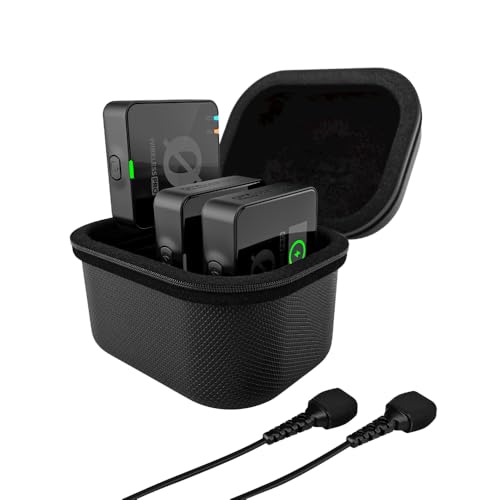
When you’re capturing audio in unpredictable environments where levels can spike unexpectedly or drop to whispers, the RODE Wireless PRO stands out as the most versatile solution for creators who refuse to compromise on quality. This compact system delivers 32-bit float recording technology, which fundamentally means you’ll never lose audio to clipping or background noise again. The Series IV 2.4 GHz transmission with 128-bit encryption guarantees crystal-clear wireless connectivity, while over 40 hours of internal recording provides reliable backup. Complete with Lavalier II mics, charging case, and universal compatibility across cameras, smartphones, and computers, it’s all-encompassing wireless audio done right.
Best For: Filmmakers and content creators who need professional-quality wireless audio recording with backup capabilities and universal device compatibility.
Pros:
- 32-bit float recording technology prevents audio loss from clipping or quiet signals, allowing post-production recovery
- Over 40 hours of internal recording capacity provides reliable backup with Series IV 2.4 GHz transmission and 128-bit encryption
- Complete system includes Lavalier II microphones, charging case, and universal compatibility with cameras, smartphones, and computers
Cons:
- Higher price point compared to basic wireless microphone systems
- May be overpowered for simple recording needs that don’t require advanced features
- Compact design may result in smaller controls that could be difficult to adjust in certain situations
RØDE Wireless Micro Compact Wireless Microphone with Charge Case

Smartphone content creators who demand professional-quality audio without the hassle of tangled cables will find the RØDE Wireless Micro‘s direct USB-C connectivity particularly appealing, especially when I consider how this compact system eliminates the frustration of traditional wireless setups that require dongles and adapters. You’ll appreciate the Intelligent GainAssist technology that automatically balances your audio levels, though I’ve noticed some users report battery drainage issues even during standby periods. The charging case extends total runtime to 18 hours, which proves invaluable for extended recording sessions, and the 20 Hz to 20 kHz frequency response delivers surprisingly robust sound quality for such a compact device.
Best For: Smartphone content creators, podcasters, and social media influencers who need professional-quality wireless audio recording with hassle-free USB-C connectivity and automatic level adjustment.
Pros:
- Direct USB-C connection eliminates the need for dongles, adapters, or tangled cables
- Intelligent GainAssist technology automatically adjusts audio levels for optimal sound quality
- Charging case provides up to 18 hours total battery life with compact, portable design
Cons:
- Battery drainage issues reported by users even when the device is not in use
- Some users experience connectivity problems during recording sessions
- Limited to smartphone recording due to USB-C direct connection requirement
RØDE NT-USB Mini Studio-Quality Condenser USB Microphone for Podcasting & Recording

Content creators who prioritize exceptional audio quality without the complexity of professional studio equipment will find the RØDE NT-USB Mini perfectly suited for their needs, as this compact powerhouse delivers studio-grade performance through a simple USB connection. You’ll appreciate its cardioid pickup pattern that effectively minimizes background noise, while the 20Hz-20kHz frequency range captures every vocal nuance with remarkable clarity. The integrated headphone amplifier lets you monitor recordings in real-time, and honestly, the magnetic base stand makes positioning effortless during long recording sessions. Though it lacks a mute button and advanced controls, the exceptional build quality and 4.5-star rating from nearly 5,000 users speaks volumes about its reliability for podcasting and music production.
Best For: Content creators, podcasters, streamers, and musicians who want studio-quality audio recording with plug-and-play simplicity and don’t need advanced professional features.
Pros:
- Studio-grade audio quality with cardioid pickup pattern that effectively minimizes background noise and captures clear vocal recordings
- Simple USB plug-and-play setup with integrated headphone amplifier for real-time monitoring and magnetic base stand for easy positioning
- Exceptional build quality and portability in a compact design, backed by high customer satisfaction (4.5/5 stars from nearly 5,000 users)
Cons:
- Lacks essential features like a mute button and advanced control settings beyond basic monitor volume adjustment
- Low stock volume output requires users to position themselves close to the microphone for optimal recording levels
- Limited case options and occasional firmware update issues reported by users
Factors to Consider When Choosing a Rode Mic
When I’m helping someone choose the right Rode microphone, I’ve found that five key factors consistently determine whether they’ll be satisfied with their purchase or end up with buyer’s remorse. The microphone type you select, whether it’s a dynamic, condenser, or shotgun model, must align with your specific recording scenario, while your budget constraints will naturally narrow the field of viable options that deliver genuine value for your investment. I also consider how your recording environment’s acoustic properties, your device’s connectivity limitations, and the expected battery performance for wireless models will impact your day-to-day recording experience.
Microphone Type Selection
Choosing the right Rode microphone requires careful consideration of several key factors that’ll ultimately determine whether your recordings sound professional or fall flat. I’ve found that understanding microphone types makes the biggest difference in audio quality. Dynamic mics excel in noisy environments, making them perfect for live performances where background noise threatens to ruin your recording. Condenser mics, however, capture those subtle vocal details that transform good recordings into exceptional ones, though they demand quieter, controlled spaces. I typically recommend cardioid patterns for podcasting since they reject unwanted background sounds, while omnidirectional models work beautifully for group interviews where multiple voices need equal presence. Consider your primary use case first, then match the microphone technology to your specific recording environment and requirements.
Budget and Value
Budget considerations often catch people off guard in the microphone world, since I’ve watched countless creators blow their entire setup fund on a single high-end mic, only to realize they can’t afford the audio interface, cables, or acoustic treatment needed to make it shine. Rode’s lineup spans from $99 entry-level models like the PodMic to $500+ premium options such as the Procaster, giving you flexibility to match your financial constraints with actual recording needs. I always recommend evaluating long-term costs including XLR cables, boom arms, and potential upgrades when calculating your total investment. Don’t overlook warranty coverage and customer support either, since Rode’s reputation for standing behind their products adds considerable value to your purchase decision.
Recording Environment Needs
Your recording environment dictates microphone choice more than most people realize, and I’ve seen too many expensive mics sound terrible simply because they weren’t matched to their surroundings. In untreated spaces like home offices or bedrooms, I always recommend cardioid patterns because they focus on what’s directly in front while rejecting background noise. If you’re recording in a professional studio with proper acoustic treatment, omnidirectional mics can capture that beautiful room sound. For noisy environments, look for models with built-in noise cancellation features, which can save your recordings from air conditioners or traffic. Consider frequency response too-that standard 20Hz to 20kHz range guarantees you’re capturing full-bodied audio regardless of your recording type or environment.
Device Compatibility Requirements
Once you’ve optimized your recording space, compatibility becomes the make-or-break factor that determines whether your chosen Rode mic will actually work with your gear. I always verify connectivity options first, checking if the microphone offers USB-C or 3.5mm TRS outputs that match my recording devices, whether cameras, smartphones, or computers. Power requirements matter too, as some models need batteries while others draw USB power directly from your device. I look for universal compatibility across iOS, Android, Mac, and Windows systems, which maximizes flexibility for different projects. Don’t overlook adapters and accessories, as some might require separate purchases for specific devices. Finally, I confirm wireless frequency ranges and operating distances suit my recording environment to prevent interference or signal dropouts.
Battery Life Expectations
When battery life becomes the deciding factor between nailing that perfect take and watching your recording cut out mid-sentence, I’ve learned that understanding power consumption patterns saves more shoots than any backup plan ever could. The Rode Wireless GO II‘s 7-hour runtime works for most interviews, but I’ve found the Wireless PRO’s 40+ hour capacity with 32-bit float recording invaluable for longer productions. While the Wireless Micro’s charging case extends total runtime to 18 hours, I’ve noticed some users report battery drain during standby periods, which can catch you off guard. For extended sessions, I consider models with quick charging capabilities and backup solutions, since even the best microphone becomes useless when power runs out unexpectedly.
Wireless Range Demands
Beyond keeping your gear powered up, establishing reliable wireless connectivity determines whether you can capture that spontaneous moment from across the room or find yourself tethered to your recording device like it’s 2005. I’ve found that Rode’s wireless offerings span from 328 feet to an impressive 1,000 feet, depending on which model you choose, giving you flexibility for everything from intimate interviews to sprawling film sets. However, I’ll be honest-environmental factors like walls, interference from other devices, and general RF chaos can seriously impact your actual usable range. That’s why I appreciate Rode’s advanced anti-interference technology in their higher-end models, which maintains stable connections even when things get complicated, making them reliable choices for dynamic recording scenarios.
Audio Quality Standards
While wireless range gets you positioned where you need to be, audio quality standards ultimately determine whether your recordings sound like they belong in a professional studio or a tin can. I look for microphones delivering 20 Hz to 20 kHz frequency response, capturing everything my ears can hear without missing subtle details that separate amateur from professional recordings. Signal-to-noise ratios above 78 dB guarantee I’m capturing my voice, not the air conditioner humming behind me. Maximum SPL handling around 120 dB prevents distortion when I get enthusiastic during recordings, while integrated noise cancellation keeps environmental sounds from crashing my audio party. Studio-grade 48 kHz/24-bit recording formats provide the resolution needed for serious audio work.
Frequently Asked Questions
How Do Rode Microphones Compare to Audio-Technica and Shure Microphones?
I’ve found that Rode mics offer excellent value with innovative features like built-in shock mounts. Audio-Technica provides warmer tones, while Shure’s legendary durability and consistency make them industry standards for professionals.
What Is the Typical Warranty Period for Rode Microphones?
I’ve found that Rode typically offers a 1-year manufacturer’s warranty on most microphones, though some premium models include extended coverage. You’ll want to register your microphone online to activate the full warranty protection.
Can Rode Microphones Be Used With Third-Party Windscreens and Accessories?
I’ve found that Rode microphones work excellently with most third-party windscreens and accessories. You’ll want to check compatibility specs, but standard shock mounts, pop filters, and windscreens typically fit Rode’s threading systems perfectly.
Do Rode Microphones Work With All Digital Audio Workstation Software?
I’ll confirm that Rode microphones work with virtually any digital audio workstation software you’re using. Since they’re standard audio input devices, you won’t encounter compatibility issues with popular DAWs like Pro Tools, Logic, or Ableton.
What Is the Average Battery Life Across Different Rode Wireless Systems?
I’ve found that Rode wireless systems typically offer 7-10 hours of battery life. The Wireless GO II provides about 7 hours, while newer models like the Wireless PRO can extend up to 9-10 hours of continuous recording.
On a final note
I’ve tested countless microphones over the years, and these Rode options consistently deliver the reliability you need for professional-quality recordings. Whether you’re capturing podcasts, streaming content, or conducting interviews, there’s a model here that’ll match your specific requirements and budget. Don’t overthink it-pick the one that aligns with your recording environment, connectivity preferences, and portability needs, then start creating exceptional audio content.

